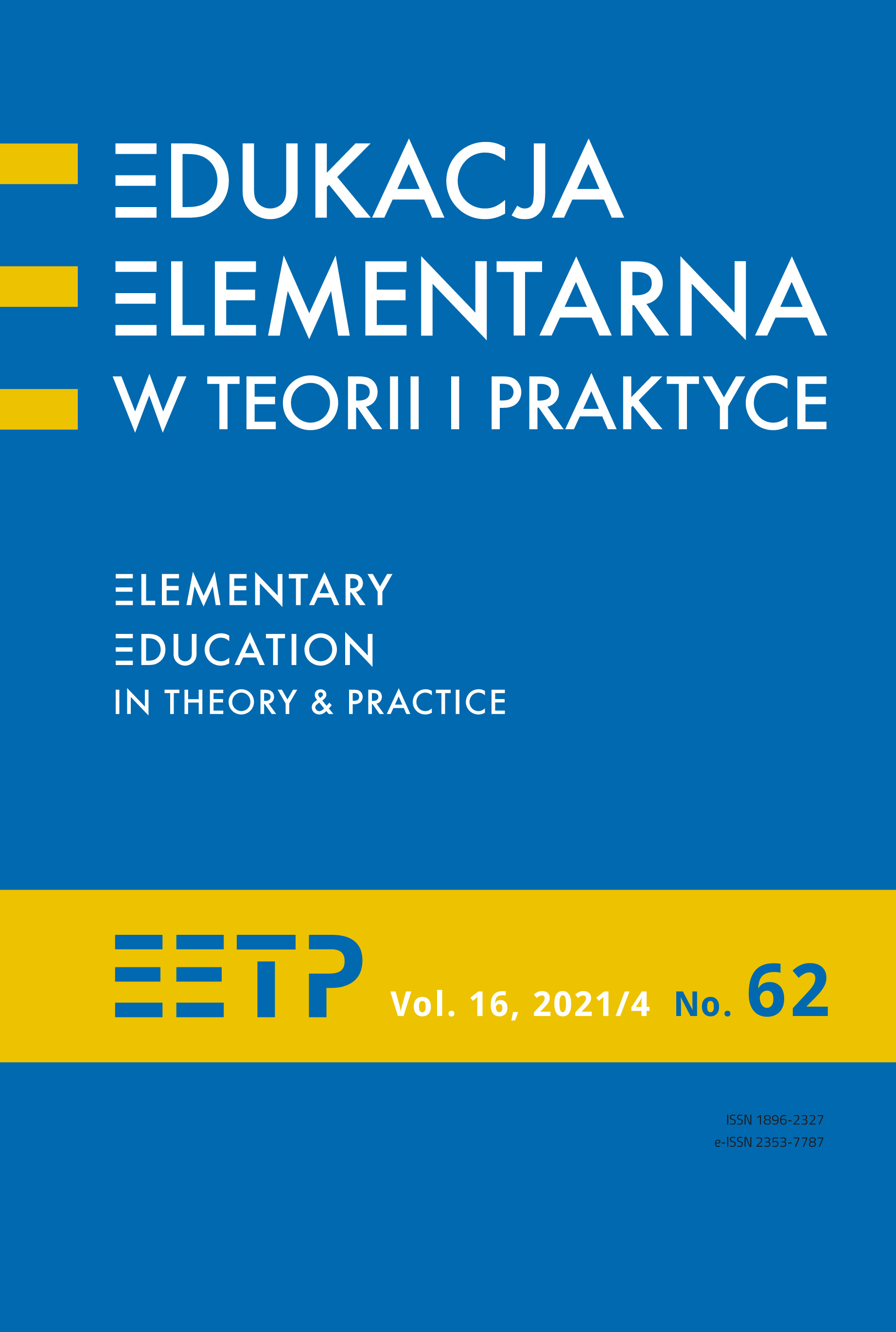What the Socks Told Me ... – a Model of a Literary Character in the Prose of Justyna Bednarek
Abstract
The text concerns the books for children of the contemporary Polish writer - Justyna Bednarek. The researcher dealt with the first two parts of the cycle about socks [part I: Amazing Adventures of 10 Socks (Four Right and Six Left Ones) – 2015; part II: New (Even More Amazing) Adventures of Socks – 2017]. The basic subject is showing a model of a new literary hero in the writer’s works by selecting significant “life truths” represented by the characters of socks. The researcher refers to the reflection on objects in children’s literature. She searches for contexts in pedagogy, psychoanalysis and culture. She tries to discover the world of things shown in the book through the stories of the title characters subject to personification. She interprets the figure of a sock, created by Bednarek, seeing in it a cultural role model for contemporary children-readers.
References
Baluch A. (1998). Czyta, nie czyta… (o dziecku literackim), Kraków: Wydawnictwo Edukacyjne.
Bauman Z. (2015). O przemijaniu trwania [w:] Śmieć w kulturze, red. K. Kulikowska, C. Obracht-Prondzyński, Gdańsk: WN Katedra, s. 35–47.
Benedict R. (2008). Wzory kultury, Warszawa: Warszawskie Wydawnictwo Literackie MUZA.
Bodei R. (2016). O życiu rzeczy, przeł. A. Bielak, Łódź: Przypis.
Bruner J.S. (1971). O poznawaniu, przeł. E. Krasińska, przedmowa B. Suchodolski, Warszawa: Państwowy Instytut Wydawniczy.
Estés C.P. (2001). Biegnąca z wilkami. Archetyp dzikiej kobiety w mitach i legendach, przeł. A. Cioch, Poznań: Zysk i S-ka Wydawnictwo.
Golka M. (2015). Nadmiar i śmieć w kulturze, [w:] Śmieć w kulturze, red. K. Kulikowska, C. Obracht-Prondzyński, Gdańsk: WN Katedra, s. 49–76.
Kondo M. (2015). Magia sprzątania. Japońska sztuka porządkowania i organizacji, Warszawa: MUZA.
Kopaliński W. (1999). Słownik symboli, [hasło: stopa], Warszawa: Wiedza Powszechna, s. 402–404.
Kretek H. (2012). Teorie i stadia rozwoju moralnego dzieci i młodzieży, „Nauczyciel i Szkoła”, nr 1(51), s. 55–69.
Rąbkowska E. (2019). Kulturowe obrazy zwierząt w polskiej literaturze dla dzieci i młodzieży w perspektywie ‘animal studies’. Wybrane problemy, niepublikowana praca doktorska pisana pod kierunkiem Grzegorza Leszczyńskiego i Anny Barcz, Warszawa: Uniwersytet Warszawski.
Shusterman R. (2010). Świadomość ciała. Dociekania z zakresu somaestetyki, Kraków: Univeristas.
Skowera M. (2019). W krainie odpadów. Wszystkie śmieci LonNiedynu Chiny Miéville’a, [w:] O czym mówią rzeczy? Świat przedmiotów w literaturze dziecięcej i młodzieżowej, red. A. Mik, M. Niewieczerzał, E. Rąbkowska, G. Leszczyński, Warszawa: Wydawnictwo SBP, s. 197–221.
Sławiński J. (1976). Słownik terminów literackich, Wrocław–Warszawa–Kraków–Gdańsk: Zakład Narodowy im. Ossolińskich.
Tylicka B. (1999). Bohaterowie naszych książek. Przewodnik po literaturze dla dzieci i młodzieży, Łódź: Wydawnictwo Literatura.
Ungeheuer-Gołąb A. (2009). Gdy króluje ars. Ikoniczne wzorce ruchowe jako warunki rozpoznania [w:] A. Ungeheuer-Gołąb, Wzorce ruchowe utworów dla dzieci. O literaturze dziecięcej jako wędrówce, walce, tajemnicy, bezpieczny miejscu i zabawie, Rzeszów: Wydawnictwo Uniwersytetu Rzeszowskiego, s. 201–300.
Willi J. (1996). Związek dwojga. Psychoanaliza pary, przeł. M. Szewcow-Szewczyk, Warszawa: Jacek Santorski & Co.
Bednarek J. (2015). Niesamowite przygody 10 skarpetek (czterech prawych i sześciu lewych), il. Daniel de Latour, Warszawa: Poradnia K.
Bednarek J. (2017). Nowe przygody skarpetek (jeszcze bardziej niesamowite), il. Daniel de Latour, Warszawa: Poradnia K.
Copyright (c) 2021 Elementary Education in Theory and Practice

This work is licensed under a Creative Commons Attribution-NoDerivatives 4.0 International License.
- When submitting a text, the author declares that he/she is the Author of the article (hereinafter referred to as the “Work”) and:
- he/she owns the exclusive and unlimited copyright to the Work,
- is entitled to dispose of the copyright to the Work.
Declares that it does not infringe any third party copyrights or legal rights.
Declares that there is no conflict of interest.
2. At the same time, the Author grants the Ignatianum University in Cracowa royalty-free, non-exclusive and territorially unlimited licence to use the Work in the following fields of exploitation:
- recording the Work in a hard copy, as well as on a digital or magnetic medium;
- reproduction of the Work using any technique, without limitation of the number of editions or copies;
- distribution of the Work and its copies on any medium, including marketing, sale, lending, and rental;
- introduction of the Work into a computer memory;
- disseminating the Work in information networks, including in the Internet;
- public performance, exhibition, display, reproduction, broadcasting and re-broadcasting, as well as making the Work available to the public in such a way that everyone can have access to it at a time and place of their own choosing;
- within the scope of dependent rights to the Work, including in particular the right to make necessary changes to the Work resulting from editorial and methodical development, as well as to translate the Work into foreign languages;
The licence is granted from the moment of the transfer of the Work to the Ignatianum University in Cracow. The Ignatianum University in Cracow is entitled to grant further sub-licences to the Work within the scope of the right granted. The licence is time-limited and it is granted for a period of 15 years, starting from the date of its granting.
Authors are permitted and encouraged to publish their text online (e.g. in their institution’s repository or on the institution’s website) before or during the submission process as this may lead to beneficial exchanges, as well as earlier and greater citation of the published text (See The Effect of Open Access). We recommend using any of the following portals of research associations:
- ResearchGate
- SSRN
- Academia.edu
- Selected Works
- Academic Search




